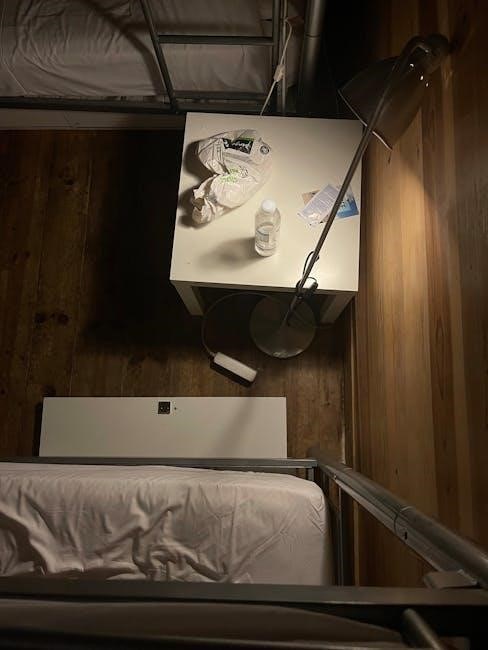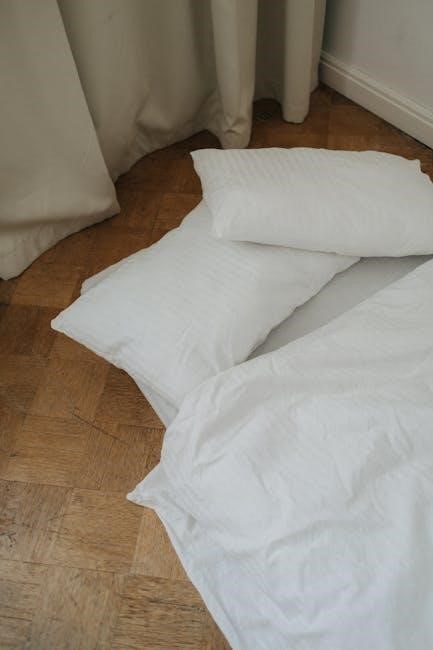Safety Precautions
Always follow safety guidelines to ensure a secure assembly process. Check weight limits (225 lbs upper‚ 400 lbs lower) and use mattresses within specified dimensions (74-75″ L x 37.5-38.5″ W). Keep warning labels visible and ensure mattress thickness does not exceed 6″. Adult assembly is required‚ and small parts should be kept away from children.
1.1. Weight Limits and Restrictions
Ensure the futon bunk bed is used within specified weight limits: 225 lbs for the upper bunk and 400 lbs for the lower bunk. Exceeding these limits can cause instability. Always verify the weight capacity before use. Additionally‚ ensure the mattress thickness does not exceed 6 inches and fits within the guardrails to maintain safety and structural integrity. Never overload the bed beyond recommended limits to prevent potential hazards.
1.2. Mattress Size and Thickness Requirements
Use a twin-sized mattress (74-75″ L x 37.5-38.5″ W) for the upper bunk and a full-sized mattress for the lower bunk. The mattress thickness must not exceed 6 inches. Ensure the mattress surface is at least 5 inches below the guardrails to meet safety standards. Proper sizing prevents entrapment risks and ensures structural stability. Always follow these guidelines for safe assembly and usage of the futon bunk bed.
1.3. Warning Labels and Compliance Standards
Adhere to all warning labels on the bunk bed and packaging. Do not remove any labels‚ as they provide critical safety information. The bed complies with ASTM F-1427 and 16 CFR parts 1213‚ 1500‚ and 1513. Ensure all safety standards are met to prevent accidents. Follow the manufacturer’s guidelines for proper assembly and usage to guarantee structural integrity and user safety throughout the product’s lifespan.

Tools and Hardware Needed
Required tools include an Allen wrench and screwdriver. Hardware includes bolts‚ screws‚ and washers. Ensure all parts from the package are present before starting assembly.
2.1. List of Required Tools
The essential tools needed for assembly include an Allen wrench for bolts‚ a screwdriver for screws‚ and a wrench for tightening. Additionally‚ pliers may be useful for gripping small parts‚ and a rubber mallet can help with tapping pieces into place. Ensure all tools are readily available and within reach to streamline the process. Refer to the hardware package list to verify all components are present before beginning.
2.2. Hardware Package Contents
The hardware package includes bolts‚ screws‚ and Allen wrenches for securing frames and rails. Small parts like washers and nuts are provided to ensure stability. Verify the presence of all items listed in the manual before starting assembly. Missing parts should be reported immediately to avoid delays. Ensure all hardware is compatible with the specific bunk bed model to guarantee a safe and sturdy structure. Double-check the package contents against the provided list.
Workspace Preparation
Clear the assembly area to ensure ample space for laying out components. Organize all parts and hardware nearby for easy access. Keep the workspace clean and dry.
3.1. Clearing the Assembly Area
Before starting‚ ensure the assembly area is completely clear of clutter‚ fragile items‚ and obstacles. Move furniture aside to create ample space for laying out parts. Cover the floor with cardboard or a drop cloth to protect it from damage. Ensure good lighting and check for any uneven surfaces or tripping hazards. Verify the area is large enough to accommodate the fully assembled bunk bed dimensions (201cm width‚ 177.5cm depth‚ 165cm height). This step ensures a safe and efficient assembly process.
3.2. Organizing Parts and Components
Begin by carefully unpacking and categorizing all parts from the boxes (Box 1: head/footboards‚ Box 2: futon decks and stretchers‚ Box 3: guard rails and ladder) and the hardware package. Use a checklist to verify the presence of every item‚ ensuring none are missing or damaged. Separate and label hardware (bolts‚ screws) in small containers for easy access. Arrange larger components in logical groups based on assembly sequence. Keep tools like the Allen wrench within reach and ensure the workspace remains tidy to prevent misplacement and streamline the process.
Assembling the Lower Bunk
Attach side rails and support legs to the lower bunk frame using small bolts and an Allen wrench. Secure all connections firmly for stability.
4.1. Attaching Side Rails and Support Legs
Begin by aligning the left and right side rails with the lower bunk frame. Secure them using the provided small bolts and tighten firmly with an Allen wrench. Next‚ attach the support legs to the corners of the frame‚ ensuring they are evenly spaced and tightly fastened. Double-check all connections for stability before proceeding to the next step.
4.2. Securing the Lower Bunk Frame
Once the side rails and support legs are attached‚ ensure the lower bunk frame is stable. Tighten all bolts using the Allen wrench provided‚ verifying that all connections are secure. Double-check that the frame is level and evenly balanced. Ensure the mattress area is clear of obstructions and that the weight limit (400 lbs for the lower bunk) is not exceeded. This step is crucial for safety and structural integrity.
Assembling the Upper Bunk
Begin by attaching guardrails and support slats for stability. Ensure all bolts are tightened securely and the frame is level. Follow the instructions carefully to mount the upper bunk frame safely.
5.1. Attaching Guardrails and Support Slats
Align the guardrails with the upper bunk frame‚ ensuring proper fitment. Secure them using the provided bolts and tools. Tighten firmly with an Allen wrench. Install support slats evenly across the frame for added stability. Ensure all connections are tight and the structure is level. Follow the manufacturer’s instructions for correct placement and alignment to meet safety standards and prevent shifting during use.
5.2. Mounting the Upper Bunk Frame
Place the upper bunk frame onto the lower bunk‚ aligning the pre-drilled holes. Use the provided bolts to secure it tightly. Ensure the frame is level and stable. Double-check all connections for tightness. Refer to the hardware package for specific bolt sizes and tools required. Follow the manufacturer’s guidelines to ensure a safe and proper installation‚ as outlined in the detailed assembly instructions provided with the futon bunk bed.
Converting the Futon
To convert the futon‚ remove the hooks to flatten it. Adjust the futon deck to the desired position‚ ensuring stability. Follow instructions carefully for proper conversion.
6.1. Removing Hooks for Flat Position
Begin by locating the hooks that secure the futon in its upright position. Use an Allen wrench to loosen and remove these hooks. Carefully pull the futon frame away from the hooks to disengage it. Once removed‚ ensure the futon deck is fully extended and laying flat. Double-check that all hooks are completely cleared to achieve a flat‚ even surface. This step is crucial for converting the futon into a bed.
6.2. Adjusting the Futon Deck
After removing the hooks‚ slide the futon deck forward to achieve the flat position. Ensure the deck is fully extended and aligned with the lower bunk frame. Use the adjustment mechanisms (if provided) to secure the deck in place. Verify the deck is level and stable. If the deck does not lie flat‚ consult the manual for further guidance. Proper adjustment ensures the futon functions smoothly as a bed or seating option.

Attaching Guardrails
Align guardrails with the upper bunk frame‚ ensuring proper fit and secure attachment. Tighten all bolts firmly and verify alignment with the mattress surface for safety compliance.
7.1. Installing Guardrails on the Upper Bunk
Attach guardrails to the upper bunk by aligning their brackets with pre-drilled holes. Secure using provided bolts‚ ensuring tightness. Position rails so the mattress surface is at least 5 inches below the top edge. Check alignment to prevent gaps and ensure stability. Refer to the hardware list for correct bolt sizes. Proper installation is crucial for safety and compliance with ASTM standards.
7.2. Ensuring Proper Guardrail Alignment
Verify guardrail alignment by ensuring they fit snugly against the upper bunk frame. Check that the mattress surface is at least 5 inches below the guardrail edge. Tighten all bolts securely and inspect for any gaps or misalignment. Proper alignment prevents accidents and ensures compliance with safety standards. Regularly check and adjust guardrails as needed to maintain stability and safety.

Installing the Ladder
Attach the ladder to the upper bunk using provided hardware. Ensure ladder rungs align with pre-drilled holes for secure installation. Tighten all bolts firmly for stability.
8.1. Attaching the Ladder to the Upper Bunk
Begin by locating the pre-drilled holes on the upper bunk frame. Align the ladder’s mounting brackets with these holes and secure it using the provided bolts. Tighten firmly to ensure stability and prevent wobbling. Double-check the hardware package for all necessary parts and refer to the instructions if unsure. Ensure the ladder is stable and even‚ adjusting as needed for proper alignment and safety.
8.2. Securing the Ladder for Stability
After attaching the ladder‚ ensure all bolts are tightened firmly to prevent any movement. Double-check the alignment to confirm the ladder is even and stable. Test the ladder by gently applying weight to ensure it does not wobble. Safety labels should remain intact and visible. Ensure the mattress size complies with recommended dimensions to maintain structural balance and support the ladder’s stability effectively.

Final Assembly Checks
Ensure all bolts and screws are tightened. Verify the bunk bed’s structural integrity‚ checking for sturdiness and proper alignment. Confirm compliance with safety standards.
9.1. Tightening All Bolts and Screws
Inspect all connections and tighten bolts and screws firmly using the provided Allen wrench. Ensure every joint is secure to prevent wobbling. Double-check the tightness of guardrails‚ ladder attachments‚ and frame supports. Verify that all hardware is properly aligned and snug to guarantee stability and safety. Follow the sequence in the manual to avoid missing any critical connections.
9.2. Verifying Structural Integrity
After tightening‚ test the bed’s stability by gently rocking it side to side and front to back. Ensure no parts feel loose or unstable. Check for any signs of damage or wear on frames‚ rails‚ and supports. Confirm that all components meet safety standards and weight limits specified in the manual. A sturdy structure is crucial for safe use and durability of the futon bunk bed.

Placing Mattresses
Place the twin-size mattress on the upper bunk‚ ensuring it fits within the specified dimensions (74-75″ L x 37.5-38.5″ W) and thickness (≤6″). Position the full-size futon mattress on the lower bunk‚ aligning it securely within the frame. Ensure both mattresses comply with weight limits and safety standards for optimal support and stability.
10.1. Installing the Upper Bunk Mattress
Place the twin-size mattress on the upper bunk‚ ensuring it fits within the specified dimensions (74-75″ L x 37.5-38.5″ W) and thickness (≤6″). Center the mattress to align with the guardrails‚ ensuring the surface is at least 5″ below the rail edges. Secure the mattress tightly to prevent shifting. Always check the weight limit (225 lbs for the upper bunk) to avoid exceeding capacity. Refer to the manufacturer’s guidelines for precise measurements and safety compliance.
10.2. Placing the Futon Mattress
Position the full-size futon mattress on the lower bunk‚ ensuring it fits snugly without overhanging the frame. The mattress should be designed for futon use‚ with a thickness suitable for the bed’s design. Secure it firmly to maintain stability and prevent movement. Always adhere to the weight capacity (400 lbs for the lower bunk) and ensure the mattress complies with the manufacturer’s size recommendations for optimal comfort and safety.

Attaching Warning Labels
Always attach warning labels as indicated in the manual. Place them on the bunk bed and packaging. Do not remove them. Ensure labels comply with ASTM F-1427 and 16 CFR standards.
11.1. Positioning Safety Labels
Position safety labels on the upper bunk frame and guardrails. Ensure they are visible and legible. Follow the manufacturer’s guidelines for placement. Labels should be on both sides of the bed. Avoid covering them with bedding. Secure labels firmly to prevent peeling. Compliance with safety standards is essential. Refer to the manual for specific locations. Labels must remain intact and visible at all times.
11.2. Ensuring Label Visibility
Ensure all safety labels are clearly visible after assembly. Check for damage or wear and clean labels if necessary. Verify that labels are securely attached to the bed frame and guardrails. Avoid covering labels with bedding or decorations. If labels become illegible or detached‚ replace them immediately. Compliance with safety standards requires labels to remain visible and intact. Regularly inspect labels for condition and reattach if loose. Visibility ensures critical safety information is always accessible.

Final Inspection
Inspect the entire bunk bed for completeness and structural integrity. Ensure all parts are securely tightened and correctly aligned. Verify compliance with safety standards.
12.1. Checking for Missing Parts
Before finalizing‚ cross-reference the parts list to ensure all components are present. Verify hardware packages‚ frames‚ rails‚ and accessories. Check for any damaged or missing items. If parts are missing‚ contact the manufacturer’s customer support immediately for replacement. Ensure all boxes and packaging are thoroughly inspected to confirm completeness. This step is crucial for safety and proper assembly.
12.2. Ensuring Compliance with Safety Standards
Verify that the bunk bed meets ASTM F-1427 and 16 CFR parts 1213‚ 1500‚ 1513 standards. Ensure the mattress fits within specified dimensions (74-75″ L x 37.5-38.5″ W) and thickness (≤6″). Check that the mattress surface is at least 5″ below guardrails. Confirm weight limits (225 lbs upper‚ 400 lbs lower) are not exceeded. Ensure all warning labels are visible and intact‚ and no unauthorized items are attached to the bed.

Maintenance Tips
Regularly inspect and clean the bunk bed to maintain its condition. Lubricate moving parts‚ such as hinges‚ to ensure smooth operation. Tighten loose bolts periodically for stability.
13.1. Regular Cleaning
Regular cleaning is essential for maintaining the bunk bed’s condition. Use a soft cloth and mild detergent to wipe down metal frames‚ guardrails‚ and ladders. Vacuum tight spaces and crevices to remove dust buildup. Avoid harsh chemicals that may damage finishes. Clean mattresses regularly and ensure they are dry before use. Inspect for stains or spills and address them promptly. This routine helps preserve durability and ensures a safe‚ hygienic environment.
13.2. Lubricating Moving Parts
Regularly lubricate moving parts like hinges and joints to ensure smooth operation. Use a silicone-based spray lubricant‚ applying it lightly to areas prone to friction. Wipe off any excess with a clean cloth to avoid dust buildup. Lubricate every 6-12 months‚ depending on usage. This maintenance step prevents squeaking and ensures the futon and ladder function effortlessly‚ enhancing durability and user convenience over time.

Troubleshooting Common Issues
Address wobbling by tightening loose bolts and screws. For instability‚ ensure all parts are securely assembled. Inspect for damaged components and replace them promptly to maintain safety and functionality.
14.1. Addressing Wobbling or Instability
If the bunk bed wobbles‚ inspect all bolts and screws for tightness. Ensure the frame is properly aligned and all hardware is securely fastened. Check for uneven surfaces or flooring‚ as this can cause instability. Verify that the weight distribution is even and does not exceed the recommended limits. If issues persist‚ re-examine the assembly steps to ensure no parts were misaligned or improperly secured.
14;2. Handling Damaged or Missing Parts
Immediately cease assembly if any parts are damaged or missing. Contact the manufacturer’s customer support for replacements‚ using the part numbers listed in the manual. Avoid using substitute parts‚ as they may compromise safety. Inspect all components before starting assembly‚ and ensure all tools and hardware are accounted for. Do not proceed until all issues are resolved to maintain structural integrity and safety standards.
Additional Resources
Refer to the manufacturer’s customer support for assistance with assembly and troubleshooting. Utilize online guides and videos for visual instructions and additional tips.
15.1. Manufacturer’s Customer Support
Contact the manufacturer’s customer support for assistance with assembly‚ troubleshooting‚ or replacement parts. Call the helpline at 08456 400800 for guidance or to report missing/damaged components. Refer to the provided instruction booklet for detailed support information and ensure all queries are addressed before proceeding with assembly.
15.2. Online Assembly Guides and Videos
Visit the manufacturer’s official website or platforms like sisterslogfurniture.com for detailed assembly guides and instructional videos. Resources such as the DHP 3137096 instruction booklet and specific model guides (e.g.‚ Dandelion Futon Bunk Bed instructions) are available for download. These materials provide step-by-step visuals and troubleshooting tips‚ ensuring a smooth assembly process. Refer to Page 10 of the SLF Assembly Instructions for additional guidance.
Warranty Information
Understand warranty coverage and terms for defects in materials and workmanship. Contact the manufacturer’s customer support for claims. Warranty void if product is misassembled or modified.
16.1. Understanding Coverage and Terms
The warranty covers defects in materials and workmanship for a specified period. It does not apply to misuse‚ normal wear‚ or modifications. Coverage typically lasts 1-5 years‚ depending on the manufacturer. Review the terms to understand what is included and excluded. Ensure compliance with assembly instructions to maintain warranty validity. Contact customer support for clarification on specific coverage details and conditions.
16.2. Filing a Warranty Claim
To file a warranty claim‚ contact the manufacturer’s customer support with proof of purchase and detailed photos of any defects. Ensure all necessary documentation is complete and meets the warranty terms. Submit the claim through the specified process‚ typically via email or the manufacturer’s website. Allow time for review‚ and follow up if needed; Ensure compliance with submission guidelines for a smooth process.
